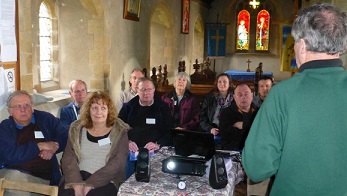M1: 23 Mar 2014 - Hollesley
Having successfully taught quite a number of people to ring over several decades and being very much “old-school” regarding ringing in general, my motivation to attend the ITTS Day Course at Hollesley Suffolk was driven more by curiosity than anything else. I considered at best I would confirm that which I already know and should I pick up any new hints or tips it would be a bonus.
The group comprised mainly ringers from Suffolk and two from North Norfolk. Half the group were signed up as Teachers and the remainder as Mentors. The introductory session presented by Graham Nabb, our Tutor for the day, outlined some background to ITTS. Graham explained how the approach was based on evidence based research about how people learn practical skills and the principle of breaking down tasks into component parts enabling the learner to master these before putting them together leading to mastery of the skill overall.
The first theory session engaged me from the outset and I wanted to know more and see what the practical sessions would offer. Although the principle of learning based on whole-part-whole was familiar to me I was keen to see how it had been applied to ringing, particularly as I had already considered this and even come up with my own approach. The remainder of the day was filled with practical session where teachers worked with mentors to experience the approaches explained in the theory sessions and expert demonstrations performed by Graham.
Having returned home after what turned out to be a most enjoyable day I reflected on my experience. Firstly this is clearly a well thought out approach to teaching to ring. The training includes lots of very good ideas and techniques to train a new recruit as well as fix common bell handling faults observed in both new and experienced ringers.
Regardless of ones interest in teaching or mentoring this training would serve any ringer well, particularly the practical sessions where working as teacher-mentor pair makes it necessary to observe, identify and correct faults by applying an appropriate exercise either recommended by ITTS or of the tutors own design.
I am sure I speak on behalf of the group in saying that Graham provided us with a most engaging day and the motivation to take our learning into the wider ringing community where we can make a difference and support an aim of ITTS to ensure ringing in general and the preservation of the ancient art is not marginalised by an increasingly competitive market for engagement in sports and social activities.
David Stanford

Course Tutor: Graham Nabb
Teaching Bell Handling
Practical advice for teachers, right from the first lesson.